![]() In a recent issue of Physical Review Letters was an article with the intriguing (to me) title of “Experimental verification of reversed Cherenkov radiation in left-handed metamaterial,” by a collaboration from Zhejiang University in China and MIT. The paper is an experimental verification of an effect predicted for metamaterials way back in 1968 by the originator of metamaterials research, Victor Vesalago, in his original paper, “The electrodynamics of substances with simultaneously negative values of ε and μ.”
In a recent issue of Physical Review Letters was an article with the intriguing (to me) title of “Experimental verification of reversed Cherenkov radiation in left-handed metamaterial,” by a collaboration from Zhejiang University in China and MIT. The paper is an experimental verification of an effect predicted for metamaterials way back in 1968 by the originator of metamaterials research, Victor Vesalago, in his original paper, “The electrodynamics of substances with simultaneously negative values of ε and μ.”
Čerenkov radiation (I prefer this spelling) is an effect analogous to the sonic boom created by projectiles moving faster than the speed of sound. Čerenkov radiation is emitted by ultra-high speed charged particles moving in matter. In ordinary matter, this radiation travels along the direction of motion of the particle; in a negative refractive index material, Vesalago predicted that Čerenkov radiation will travel in a direction opposite of the direction of the particle. Now, we have some preliminary experimental evidence supporting this prediction.
Let’s begin by describing the idea of a sonic boom! When an aircraft is flying through the air, it produces sound waves that emanate outward spherically from their point of origin. For aircraft flying at less than the speed of sound, the aircraft always lies within the spherical waves:
The wavefronts emanated by the aircraft at different times are numbered corresponding to their point of origin.
When the aircraft moves faster than the speed of sound, however, it outruns its wavefronts. The envelope of those wavefronts form a cone behind the aircraft:
This cone of sound produces a “sonic boom” when it passes an observer.
The opening angle of the cone can be found using some elementary trigonometry, knowing the speed of the aircraft and the speed of sound:
From the figure, it follows that
.
Just to give you an idea of the numbers involved, an aircraft traveling at Mach 2 (twice the speed of sound, or 680 m/s) would produce a shock cone of 30°. A craft moving at the barrier to hypersonic speed, Mach 5, would produce a shock cone 11°.
Another way to interpret the cone is to describe the direction that the emitted shock wave is traveling. We draw a modified version of the previous figure:
With this picture, we see that the shockwave travels at an angle to the direction of motion of the aircraft satisfying:
.
We now can ask if it is possible to produce a shockwave of light (an “optical boom”?) using a fast-moving source of radiation. We immediately run into the problem that, as first predicted by Einstein in his special theory of relativity, nothing can travel faster than the vacuum speed of light.
The operative word in the preceding sentence, however, is “vacuum”: light traveling in an ordinary material medium has its speed reduced by the refractive index of the medium . If the speed of light in vacuum is
, and the speed in the medium is
. Charged particles moving in the medium at speeds greater than
are moving faster than the speed of light in the medium and have the potential to produce “optical booms”.
This is, in essence, the process of Čerenkov radiation. A charged particle moving at a speed greater than the speed of light produces secondary radiation that moves slower than the original particle. This secondary radiation, moving slower than the original particle, forms a “shock cone” of light that is traveling along the direction of the particle.
There is one question raised in the preceding discussion: why does the relativistic particle radiate at all? An aircraft produces sound waves at any velocity; charged particles moving at a constant speed in a material medium, however, only radiate when they exceed the speed of light.
When a charged particle moves through a medium, it disrupts the electrons and atoms as it passes near them. These disturbed particles accelerate and in principle produce their own secondary radiation as they return to equilibrium. For a slow-moving charged particle, the radiation fields of neighboring atoms tend to cancel out and little to no secondary radiation is produced. For a charged particle exceeding light speed in the medium, however, the disturbance of the medium happens too rapidly for the radiation fields to cancel out, and in fact there is a constructive interference of the secondary radiation. In essence, the relativistic charged particle itself is not radiating; it excites atoms in the medium which themselves produce the secondary, Čerenkov, radiation.
Given that the speed of light in matter is , we may write the angle at which Čerenkov radiation is emitted as
.
The first experimental observations of Čerenkov radiation were reported1 in 1934 by none other than Pavel Alekseyevich Cherenkov, who jointly won the 1958 Nobel Prize in Physics for his discovery. This original paper is hard to come by (and in Russian, I believe), but in 1937, he published a short letter in Physical Review2 summarizing his results. (I’ll have to make this the subject of a ‘classic papers’ post in the future.)
Čerenkov radiation is what gives nuclear reactor cores an eerie blue glow:
(Picture of the Advanced Test Reactor, via Wikipedia.)
Because the behavior of Čerenkov radiation is related to the velocity and hence energy of the charged particle, it has been used as the basis of detectors in astrophysics and particle physics.
With this background out of the way, we now turn to a discussion of Čerenkov radiation in metamaterials that exhibit negative refractive index, i.e. . I’ve discussed such metamaterials a number of times before, most notably in the post, “What does negative refraction look like?“. The two most familiar effects associated with negative refractive index are the predictions of negative refraction, in which a light beam is bent upon entering a material in the opposite direction from normal refraction:
and so-called “slab imaging”, in which a slab of negative index material acts as a lens:
We may add to this collection the idea of “negative Čerenkov radiation”, also originally predicted by Vesalago. Naively substituting a negative refractive index into the equation for Čerenkov radiation, i.e. , we find that
.
The addition of the minus sign means that the angle of propagation of the shockwave is increased by 180°, resulting in a picture of the form:
The picture suggests that Čerenkov radiation travels backwards (opposite the direction of the particle) when it is generated in a negative index material!
Is this naive description of the process accurate, though, or are we improperly applying the formula for the direction of Čerenkov radiation? To answer this, we switch to a wave picture of negative refraction.
In a previous post, I explained that there are multiple descriptions of the velocity of a wave in matter. The so-called phase velocity of light is the velocity inversely proportional to the refractive index, i.e.
.
If the refractive index of a material is negative, then the phase velocity is negative, and the light goes “backwards”! Because the refractive index of a material generally depends on the frequency of the light traveling through it, i.e. , the phase velocity itself depends on frequency, and only represents the overall velocity of a light wave if that wave is very nearly monochromatic (single frequency). A better (but not perfect) description of the velocity of a light wave is the so-called group velocity, which depends on how the refractive index changes as a function of frequency.
Any light wave may be mathematically expressed as a superposition of monochromatic waves (in what is known as Fourier analysis), and so we may gain insight into our Čerenkov problem by considering radiation from a collection of monochromatic sources. Let us suppose that we have a collection of monochromatic point sources equally spaced on a line, and sources to the right are phase delayed relative to the sources on the left (the sources on the left radiate “sooner”). The picture of the waves looks very similar to the first picture we drew for Čerenkov radiation:
The circles represent the peaks of monochromatic waves. A set of peaks from individual sources that are in phase with one another are colored in red. Point source 4 emits a wave peak before source 3 and 3 before 2, etc. The envelope of these spherical waves is a wave forming the usual Čerenkov cone.
If the phase velocity is negative, however, the spherical waves do not spread outward from the point sources, but instead converge towards them. The net result is a set of planar wavefronts traveling in the opposite direction from the direction they travel in a positive material:
Point source 4 is still “ahead” of the others, but because the spherical waves are converging, this means that its wave has become smaller than the corresponding ones from the other points.
The result of this construction is that one has planar phase fronts propagating in the forward direction. In fact, this would seem to indicate that the Čerenkov radiation in a negative material would propagate in the same direction as in a positive material! The crucial difference is one that cannot be shown in a picture: it turns out that, according to Maxwell’s equations, the energy flow in a negative index material is in the opposite direction as to the direction of motion of the phase fronts! This means that the naive picture of Čerenkov radiation in a negative index material is accurate, at least theoretically.
Frequency by frequency, then, the result of a negative refractive index is the formation of planar waves carrying energy in a sense opposite of that for positive index materials. Provided the dispersion (frequency-variation) of the refractive index is not too great, the summation over all frequencies results in Čerenkov radiation traveling in a direction opposed to the motion of the charged particle.
With this in mind, we now turn to the question of experimentally observing such reversed Čerenkov radiation. The problem is not a trivial one, for two related reasons:
- It is difficult to construct a material that truly has a negative refractive index,
- Other materials can, in the right circumstances, produce effects identical to negative index materials, “faking” negative index effect.
The second point is a difficult one both experimentally and philosophically. In a previous post, I noted that negative refraction has been demonstrated in plasmonic materials and in photonic crystals in the absence of a negative refractive index; “reversed Čerenkov radiation” has also been demonstrated in photonic crystals3. This means that it is not sufficient to demonstrate negative refraction or reversed Čerenkov radiation experimentally; one must also demonstrate theoretically that the material in question acts like it has a negative index.
The first point also leads to a very big experimental challenge: it is not really possible yet to make a bulk sample of a metamaterial that has a negative index at optical frequencies. The wavelength of visible light is very short (500 nanometers — 500 billionths of a meter), and the construction of a metamaterial requires that the material be manipulated at a scale much smaller than the wavelength. Experiments on metamaterials are typically done at microwave frequencies, where the wavelength (about 3.5 cm) is much more reasonable.
But what does one use as a source for Čerenkov radiation? As we have seen, particles moving at relativistic speeds produce blue Čerenkov radiation, which is visible light — and we are unable to produce metamaterials for blue light.
The experimenters instead use a very clever idea that is not much different from the monochromatic point source model I described above! They built a microwave waveguide of rectangular shape, with slots cut into the top of it at regular intervals, as illustrated below:
Single-frequency microwaves are injected into the end of the waveguide, and are emitted through the slots in a manner very similar to our point source picture. The waves emitted from the slots automatically possesses a phase delay because the input microwaves take a longer time to travel to the more distant slots. The result is a source that is effectively a “monochromatic Čerenkov source”. By placing a metamaterial on top of the waveguide, one can observe the behavior of these monochromatic Čerenkov waves in a negative index material.
One other challenge had to be overcome by the experimenters. Let us suppose we place a flat slab of metamaterial on top of the slotted waveguide, and try and detect the appearance of Čerenkov radiation propagating in the reverse direction. This radiation, however, is negatively refracted when it exits the metamaterial, and ends up traveling in the same direction as ordinary Čerenkov radiation!
To resolve this, the experimenters actually produced a “prism” of metamaterial on top of the waveguide. The reverse and ordinary Čerenkov radiation hit the upper surface of the prism at different angles and are therefore refracted in different directions:
Because of the prism angle, the reverse Čerenkov wave gets refracted to a larger angle than the ordinary Čerenkov wave, and can be distinguished. (Actually, the experiment used a prism with the upper end to the right, which results in an even larger angular difference. This is what I get for drawing my picture without looking back at the paper.)
So what was observed? The experimenters constructed a metamaterial using a basic element that is a modified version of the familiar “split ring” resonators used in “cloaking” experiments. This metamaterial was theoretically predicted to have a negative refractive index for frequencies below 10 GHz, and to have a positive refractive index for frequencies above 11 GHz. In measuring the direction of the synthesized Čerenkov radiation, they found that the radiation traveled in the “reverse” direction in the negative index regime and in the “ordinary” direction in the positive index regime, in agreement with the theoretical predictions.
Reverse Čerenkov radiation could actually have important application in particle physics, provided a metamaterial in the visible regime can be constructed. Ordinary Čerenkov radiation travels in the same direction at the high-energy particles that produce it, and it can be difficult to separate the useful radiation from the “noise” of the high-energy particles, not to mention difficult to shield the Čerenkov detector from radiation damage. Reverse Čerenkov radiation could be measured by detectors out of the path of the radiation, improving the quality of the detected signal and improving detector lifetimes.
Is this experiment a conclusive demonstration of reverse Čerenkov radiation? Due to the subtleties and difficulties in the definition of negative index materials, I’m guessing that there will be some who will argue against it. To me, though, the experiment is a very clever one and suggests strongly the existence of the effect.
***************************************************************
1 P.A. Čerenkov, “Visible Emission of Clean Liquids by Action of γ Radiation”, Doklady Akad. Nauk SSSR 2 (1934), 451.
2 P.A. Čerenkov, “Visible radiation produced by electrons moving in a medium with velocities exceeding that of light,” phys. Rev. 52 (1937), 378.
3 Chiyan Luo, Mihai Ibanescu, Steven G. Johnson, and J. D. Joannopoulos, “Cerenkov Radiation in Photonic Crystals,” Science 299 (2003), 368.
Xi, S., Chen, H., Jiang, T., Ran, L., Huangfu, J., Wu, B., Kong, J., & Chen, M. (2009). Experimental Verification of Reversed Cherenkov Radiation in Left-Handed Metamaterial Physical Review Letters, 103 (19) DOI: 10.1103/PhysRevLett.103.194801




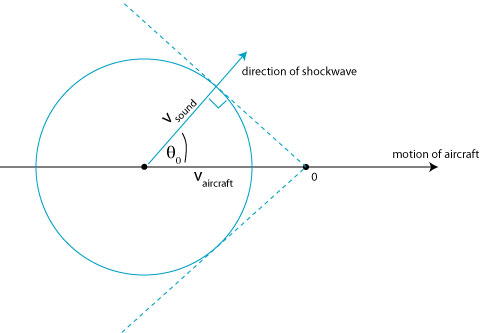
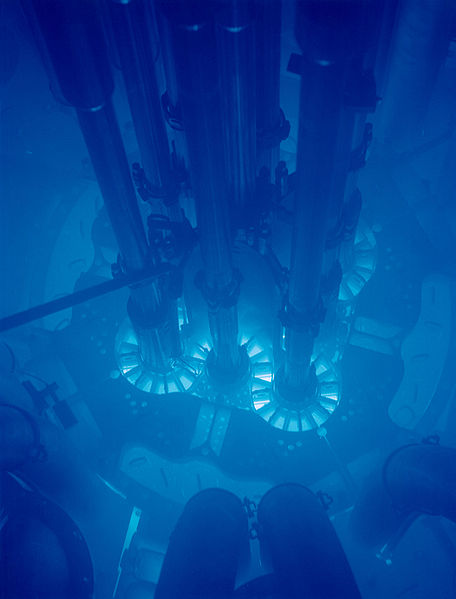

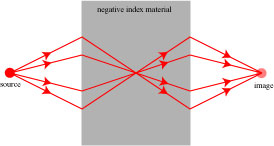

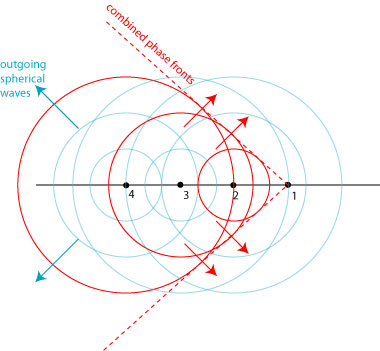


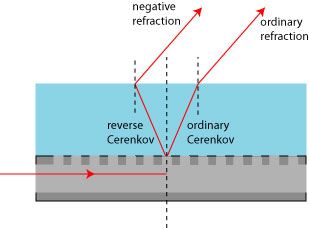


Very interesting phenomenon, and again nice drawings to illustrate it. You said: “…I’m guessing that there will be some who will argue against it…” and of course you were right!! 😉
I concur with the impression that the PRL article reports an indirect method to measure reversed Cherenkov radiation since no actual relativistic particle is involved. But one of the first thing I do when reading papers about metamaterial research is I check the dimensions involved in the system. As stated in the post, for a structured material to be considered effectively homogeneous, its constitutive elements must be much smaller than the wavelength of light. As a rule of thumb, the condition a < lambda/10 provides a good start but ideally a < lambda/20 is preferable (where "a" is the largest element's dimension and "lambda" is the wavelength). In the PRL article, for 8.5GHz source we have lambda=35mm, and a=3mm for the arrangements of rods and split-rings: thus the former condition is respected.
But things complicate further along as we note that the open slots are periodically spaced by a=10mm which is roughly a third of a lambda. While the latter might not be a serious concern since each slot can still be effectively considered as a point source; we must note that there are only 14 slots in the device for a total interaction length of 140mm, which is exactly 4 wavelengths in length. These previous observations mean that the slot arrays have dimensions comparable to the wavelength of light, and as such they are highly scattering. The large diffraction effects associated with such a small device could significantly affect the results (from my initial understanding). Of course, it is already very complicated to fabricate this type of device, minimize losses and set up this experiment, so I must give my two thumbs up for the team that did it successfully!
It would be interesting to see if one can reproduce these results using a much longer interaction length: that would make the demonstration even more convincing.
IM: Very nice observations! In my rush to complete my post, I hadn’t even thought of the separation and number of slots being used. I had a vague feeling that this result was not as conclusive as one would like, but your comment illustrates very nicely why that is.
As you said, though, credit must be given for getting an experiment like this to run at all!
P.S. The more I look at it, the more I’m uncertain that my “point source” explanation of the reverse Cerenkov effect is technically correct. It has the right idea, but I’m not sure I’ve properly taken into account the difference between energy flow and wave direction in negative materials.
I think the comparison here between an optical “shock wave” and the Cerenkov effect is a very intuitive approach to describe a very counter-intuitive phenomenon inside a negative refractive index medium.
What I did to understand the reversed direction of Cerenkov radiation is:
1. I use the figure with the z-shifted concentric circles which describes the flow of energy.
2. In the case of a positive index material: I draw one arrow in each circle starting from the center to the perimeter touching the upper line of the shock wave. The subtended angle from the arrows to z-axis of propagation is the standard direction of Cerenkov radiation.
3. In the case of a negative material: I draw one arrow in each circle starting from the perimeter touching the lower line of shock wave, and ending in the center. The subtended angle from these arrows with the z-axis is the reversed direction of Cerenkov radiation.
So the descriptions above make sense to me!
Ah, I figured out the problem with my original construction: I drew the phase fronts in the negative material wrong, and phase and energy flow are opposite one another in a negative material! I’ve updated the post with the proper discussion, which is a lot more subtle.
what would happen when a object travling light speed…came near earth…my specific question is.”what kind of shock wave would impact us”…my follow up question is could there be a defense against it
It is hard to have any particle gain velocity greater than light in air.
It is possible only with the help of the most powerful particle accilerators of
the day and that to in a very short range. It will require energy of the
order of GeVs at least if not in TeV’s. Such fast moving particles never occur
in nature. Also most part of the universe, just outside the lower atmospheric strata
is as good as vacuum. And you cannot just reach velocity > c.